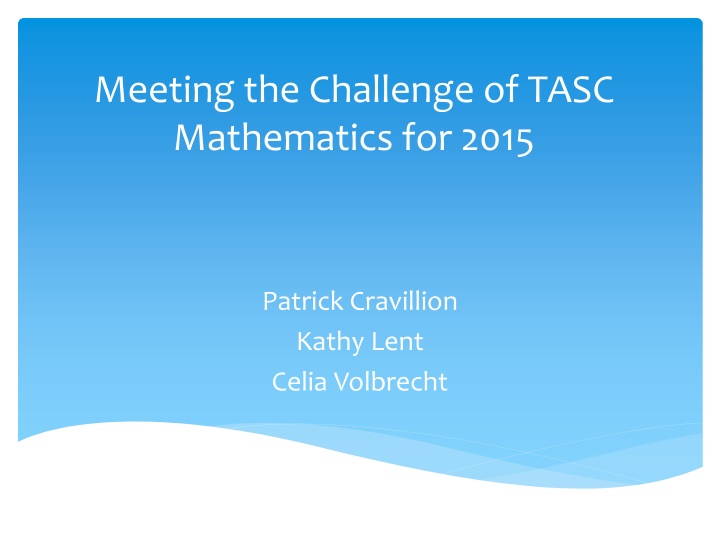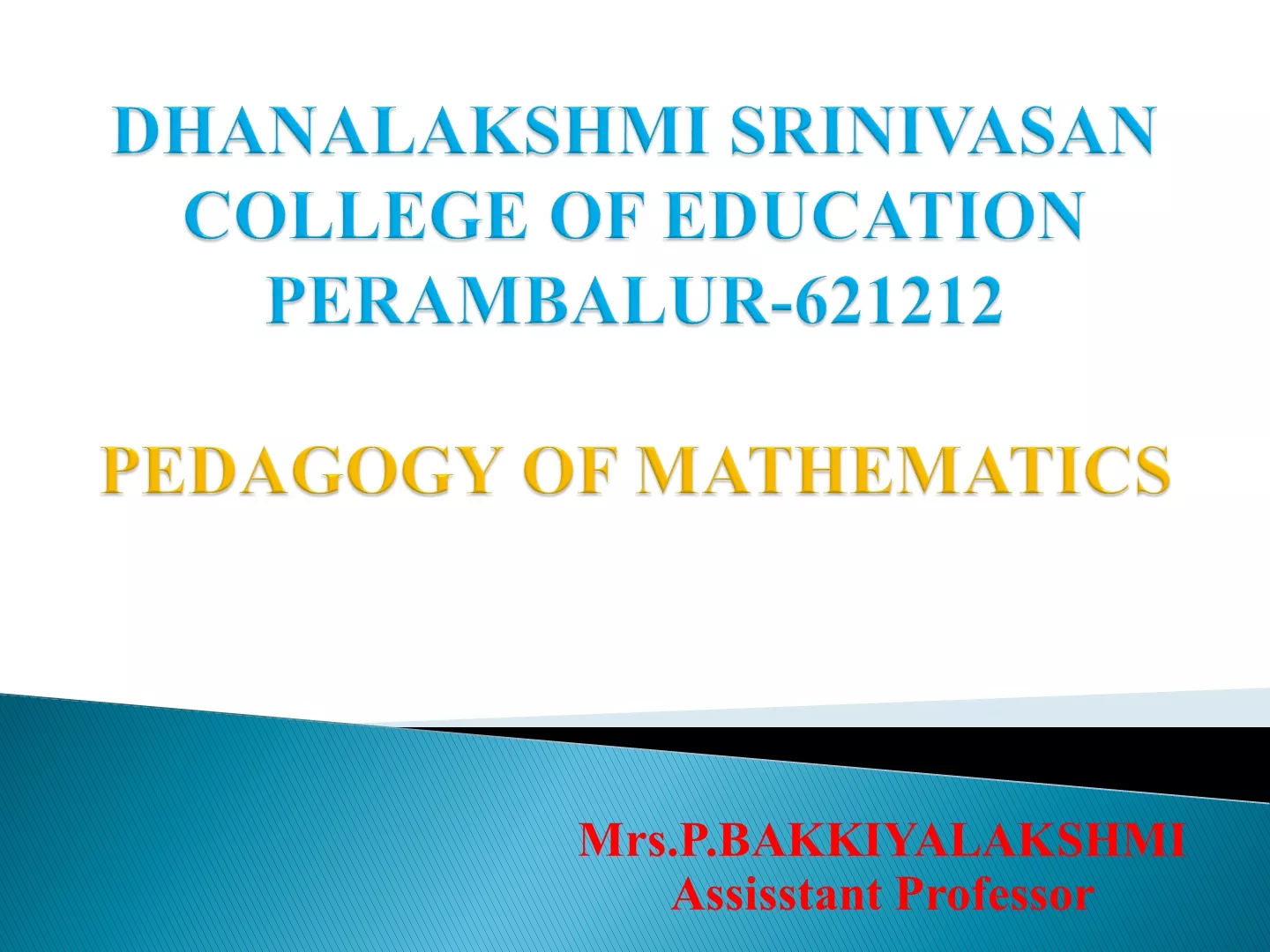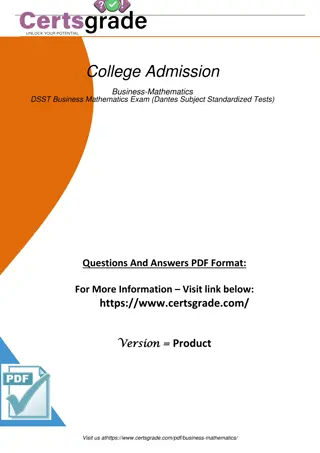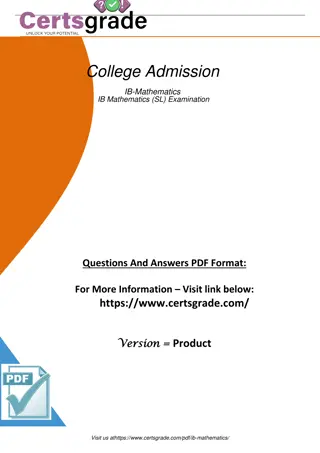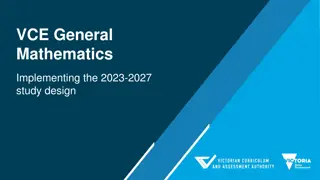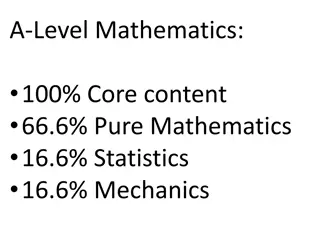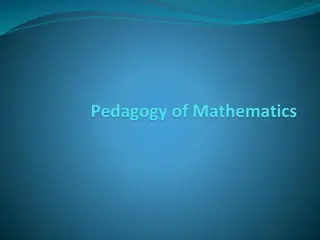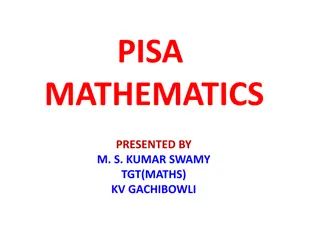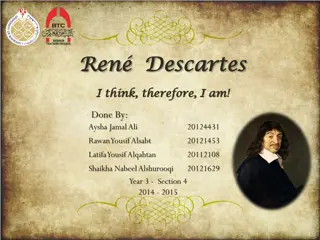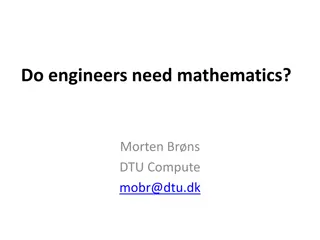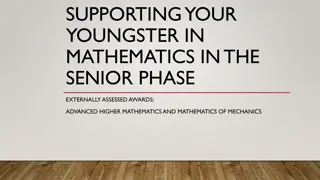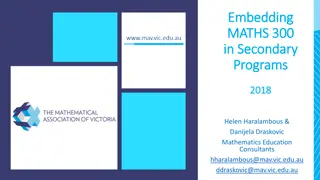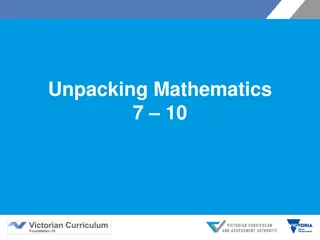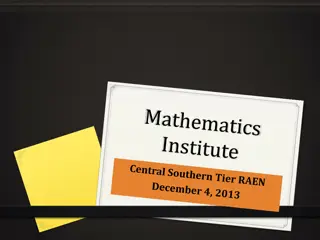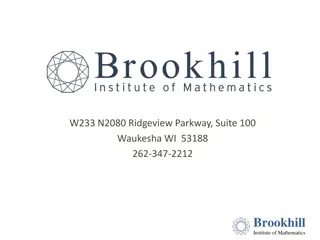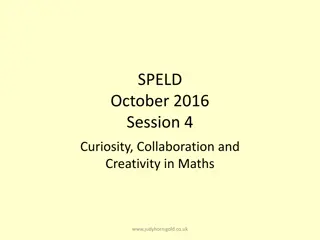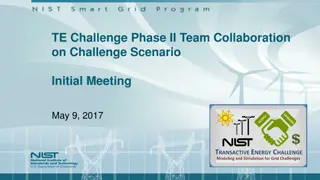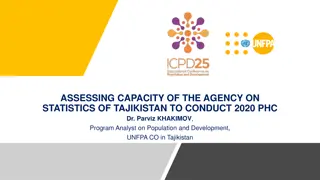Meeting the Challenge of TASC Mathematics for 2015
This content discusses the structure and content types of the 2015 TASC Mathematics exam, covering topics such as Number Sense and Operations, Algebra, Functions, Geometry, Statistics, and Probability. It emphasizes the examinees' ability to demonstrate understanding, apply rules, analyze constraints, use geometric formulas, analyze graphs, and more in solving mathematical problems.
Download Presentation

Please find below an Image/Link to download the presentation.
The content on the website is provided AS IS for your information and personal use only. It may not be sold, licensed, or shared on other websites without obtaining consent from the author.If you encounter any issues during the download, it is possible that the publisher has removed the file from their server.
You are allowed to download the files provided on this website for personal or commercial use, subject to the condition that they are used lawfully. All files are the property of their respective owners.
The content on the website is provided AS IS for your information and personal use only. It may not be sold, licensed, or shared on other websites without obtaining consent from the author.
E N D
Presentation Transcript
Meeting the Challenge of TASC Mathematics for 2015 Patrick Cravillion Kathy Lent Celia Volbrecht
2015 TASC Mathematics Content Types Content Problem Types Demonstrates Requires Demonstrate an understanding of how quantities change with respect to one another Evidence of the examinees ability to use units to solve problems Students need to understand the properties of rational and irrational numbers Number Sense and Operations Multiple choice Gridded response constructed response technology enhanced Evidence of ability to apply algebraic rules including the distributive property Students need to isolate a particular quantity of interest Algebra Multiple choice Gridded response constructed response technology enhanced Evidence of the ability to analyze and represent constraints by using a system of equations Students need to analyze graphs to determine distances and areas that depend on the scale and units of measure Functions Multiple choice Gridded response constructed response technology enhanced Evidence of the ability to recognize and use geometric formulas to compute quantitiesof interest Students need to analyze graphs to determine distances and areas that depend on the scale and units of measure Geometry Evidence of the ability to determine the subset representing possible outcomes of a question and the subset that describes the event of interest. Students need to focus selecting the proper subset of the sample space that meets the criteria using quantitative reasoning skills Statistics and Probability
2015 TASC Mathematics Content Types Content Problem Types Demonstrates Requires Multiple choice Gridded response constructed response technology enhanced Evidence of the ability to recognize and use geometric formulas to compute quantities of interest Students need to analyze graphs to determine distances and areas that depend on the scale and units of measure Geometry
TASC DOK Updates Year Level 1 Recall Level 2 Application of Skill/Concept Level 3 Explanation/ Analysis Level 4 Extended Thinking 2014 75% 10% Does Not Apply 15% 2015 65 - 85% 10 20% Does Not Apply 15 20 % 2016 55 - 75% 20 30 % Does Not Apply 10 20 %
Greatest Achievement Gap Items Algebra Indicator Code Skills/Description A-SSE.1.a Interpret parts of an expression, such as terms, factors, and coefficients. Solve equations and inequalities in one variable. Solve linear equations and inequalities in one variable, including equations with coefficients represented by letters. A-REI.3 Create equations that describe numbers or relationship. Represent constraints by equations or inequalities, and by systems of equations and/or inequalities, and interpret solutions as viable or non-viable options in a modeling context. For example, represent inequalities describing nutritional and cost constraints on combinations of different foods. A-CED.3
Greatest Achievement Gap Items Functions Indicator Skills/Description F-LE.5 Interpret expressions for functions in terms of the situation they model. Interpret the parameters in a linear or exponential function in terms of a context. F-IF.4 Interpret functions that arise in applications in terms of the context. For a function that models a relationship between two quantities, interpret key features of graphs and tables in terms of the quantities, and sketch graphs showing key features given a verbal description of the relationship. Key features include: intercepts; intervals where the function is increasing, decreasing, positive, or negative; relative maximums and minimums; symmetries; end behavior; and periodicity.
Greatest Achievement Gap Items Number and Quantity Indicator Skills/Description N-Q.3 Reason quantitatively and use units to solve problems. Choose a level of accuracy appropriate to limitations on measurement when reporting quantities.
Greatest Achievement Gap Items Statistics and Probability Indicator S-IC.4 Skills/Description Make inferences and justify conclusions from sample surveys, experiments, and observational studies. Use data from a sample survey to estimate a population mean or proportion; develop a margin of error through the use of simulation models for random sampling. S-CP.3 Understand independence and conditional probability and use them to interpret data. Understand the conditional probability of A given B as P(A and B)/P(B), and interpret independence of A and B as saying that the conditional probability of A given B is the same as the probability of A, and the conditional probability of B given A is the same as the probability of B.
Greatest Achievement Gap Items Geometry Indicator Skills/Description Apply geometric concepts in modeling situations. Apply concepts of density based on area and volume in modeling situations (e.g., persons per square mile, BTUs per cubic foot). G-MG.2 Prove theorems involving similarity. Use congruence and similarity criteria for triangles to solve problems and to prove relationships in geometric figures. G-SRT.5 G-SRT.8 Define trigonometric ratios and solve problems involving right triangles. Use trigonometric ratios and the Pythagorean Theorem to solve right triangles in applied problems.
Greatest Achievement Gap Items Geometry G-SRT.8 Define trigonometric ratios and solve problems involving right triangles. Use trigonometric ratios and the Pythagorean Theorem to solve right triangles in applied problems.
Agenda Introductions Pythagorean Triangles/Definitions Pythagoras Activity Math Interactive Same Shape Triangles Trigonometry Activity Math Interactive Trig Matching Activity Scoot Trig Look Fors Teacher/Student
Exploring the Pythagorean Theorem Math Interactives This multimedia mathematics resource shows how the Pythagorean Theorem is an important math concept used in the structural design of buildings. Using an interactive component, students construct right triangles of various sizes to explore calculations of the Pythagorean Theorem. A print activity is provided.
Exploring Trigonometry Math Interactives Trigonometry is introduced in this multimedia mathematics resource. A video explains how this math concept is used at airports to ensure the safe landing of airplanes. Using an interactive component, students explore the use of the trigonometric ratios: sine, cosine, and tangent. A trigonometry print activity is included.
Same Shapes Triangle What is a ratio? What happens to the opp/hyp ration when the angle is large? What happens to the opp/hyp ratio when the angle is small?
Same Shapes Triangle Measure each side of the triangles to the nearest millimeter and record on the Calculating ratios for similar triangles worksheet. Complete the worksheet for your triangles writing the ratios as a fraction and using a calculator to estimate to 3 decimal places. Calculate the mean values to 2 decimal places.
Same Shapes Triangle Plot the mean values on the three class graphs. What information can you observe from each graph.
Same Shapes Triangle Triangles which have the same ratios also have the same angles. This is the basis for scale drawings where although the triangles are different sizes, the angles are in the same proportion.
Same Shapes Triangle These ratios have a special name. Opp/hyp is sine of the angle (sin) Opp/Adj is cosine of the angle (cos) Opp/Adj is tangent of the angle (tan) These ratios are used in a branch of mathematics called trigonometry or trig for short.
Trig Match Triangle Expression Answer Triangle Expression Answer T1 W5 A1 T10 W9 A9 T2 W1 A7 T11 W33 A6 T3 W11 A4 T12 W24 A12 T4 W19 A14 T13 W31 A11 T5 W27 A10 T14 W26 A15 T6 W2 A3 T15 W35 A13 T7 W7 A5 T16 W22 A16 T8 W18 A17 T17 W16 A18 T9 W29 A8 T18 W20 A2
Trig Match Opposite Adjacent Hypotenuse T2 T3 T8 T10 T15 T17 T4 T6 T12 T14 T16 T18 T1 T5 T7 T9 T11 T13
Trig Match Sine Cosine Tangent T2 T3 T5 T7 T8 T10 T13 T17 T1 T6 T9 T11 T12 T14 T16 T4 T5 T18
